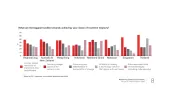
Disaster in Japan: impact on Cash Investment Strategies
Almost a month since the 11 March 2011 earthquake in Japan, and we continue to examine its impact of the damage on industries.
Japan
The magnitude of earthquake, the ensuing tsunami, aftershocks and the ongoing nuclear crisis at the Fukushima power plant will undoubtedly have an impact on Japan’s economic activity. However, we believe that, as the third largest economy in the world with GDP of nearly US$6 trillion, the country has the capacity to work its way through the current crisis, with cost estimated to reach 25 trillion yen (US$295bn). The most affected areas of Iwate, Miyagi and Fukushima account for 4.1% of GDP. Given expectations that some of the industrial production can be shifted to areas that are unaffected and that the reconstruction effort will likely lead to increased private consumption, most economists have marginally lowered Japan’s 2011 GDP forecasts to a range of 1.0%-1.5%, which is about a half-percentage point lower than expectations prior to the earthquake. While there is a risk that growth assumptions could be revised lower, it is worth noting that Japan was able to register positive GDP growth in 1995 following the massive earthquake near Kobe, Japan.
Short duration debt markets
Although Japan has an economy that is both the world’s third largest and among the world’s richest, the presence of Japanese borrowers in short duration credit markets is very modest, as Japan has its own corporate debt market and the domestic banks continue to be a major source of corporate funding. The Japanese issuers most commonly found in the US markets are the three major Japanese banks (Mitsubishi UFJ Financial Group, Sumitomo Mitsui Financial Group and Mizuho Financial Group), Toyota and Honda. However, almost all large global firms (the bread and butter of short-term corporate debt markets) have some level of sales or production exposure to Japan. In general, these exposures are very modest pieces of large, highly diversified franchises. Firms in general have not suffered catastrophic damage, such as destruction to a main factory, and damage is limited relative to the overall size of the firms.
Japanese banks
In the current fiscal year, closing at the end of March, the Japanese banks have generated relatively robust profitability; consequently, we believe they should maintain sound profitability for the current year. The impacted areas of Fukushima and Miyagi are minor markets for the big banks; consequently, the macro factors will determine the banks’ health going forward. Because we expect a dip in economic growth, we also expect a rise in credit costs, which will thin already modest profitability levels. Additionally, the recent fall in the stock market presents a concern as further declines could start to eat at the banks’ capital. Overall, after March 30 we expect stability from the banks, but with weaker profitability; consequently, we would be a bit defensive.
Japanese autos
Toyota immediately closed all 22 of its Japanese plants, reopening seven parts plants on March 17. Estimates put lost production as high as 90,000 units, or 2.4% of 2011 (year end 3/11) forecast revenues. There will likely be supply chain issues, but Toyota has already been engaged in shifting production from Japan to local markets to mitigate against a strengthening yen. Supply chain problems are likely to be a bigger headache for the Japanese makers than for non-Japanese makers, possibly putting the Japanese at a competitive disadvantage.
Supply chain issues
Technology companies rely on Japan for raw materials such as substrates for circuit chips and boards, as well as components such as handset memory and small LCD screens. Inventory levels tend to be reported as ranging from six to eight weeks. Although production may not be interrupted by the events in Japan, companies may face shortages of some components or higher prices for parts that are in short supply. These factors could negatively impact margins in the short term or result in fewer shipments.
Commodity prices
Chemical companies would be positioned to benefit if shortages from Japan boost prices in already tight chemicals markets. The chemicals sector may also experience muted sales headwinds. Petrochemical producers would also likely benefit from reductions in Japanese exports of commodity chemicals. Japan’s scarcity of natural resources makes it a key consumer of metals and mining and multi-national oil; for example, it is a major buyer of LNG and coking coal (a key input for steel manufacturing). With a significant loss of electric generation capacity resulting from nuclear shut-downs, Japan will likely boost LNG consumption. We would expect the impact of commodity price movements, whether negative or positive, to be modest relative to a firm’s overall results and generally temporary in nature.



















 Advertise
Advertise










